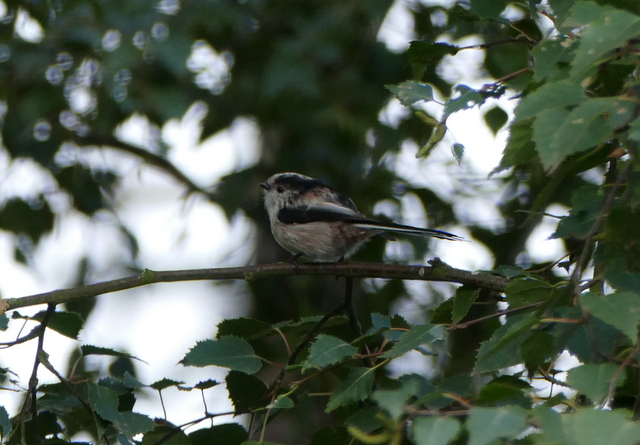The first day of a long weekend of tours today. The plan was to catch up with some lingering autumn migrants in the Wells-Holkham area. The forecast was for the possibility of thundery showers today, so we set off for the dunes at Burnham Overy with our waterproofs just in case.
As we walked out along the path across the grazing marshes, we could hear Chiffchaffs and Blackcaps calling from the hedges. A Pied Wagtail flew over calling, followed a little later by a Grey Wagtail. There were lots of Swallows and House Martins heading east over the grazing marsh, though it was harder to tell if they were on the move today or just forced down to feed by the low cloud. We had just gone through one of the gates when we heard a bird calling from the bushes behind us. We walked back and a Redstart flew out, flashing its red tail as it darted across the track and disappeared over the hedge. A nice autumn migrant to start the day.
There were several Curlew calling and a little flock dropped down onto the grazing marshes alongside the track. Several Common Snipe flew overhead, including a flock of 6, possibly flushed from the grass by a tractor topping the meadows. A large flock of Golden Plover circled out over the harbour. Standing up on the seawall, a Greenshank flew past calling and dropped down out on the saltmarsh. Further over beyond the harbour channel, we could see a little roost of Grey Plover pushed off the mud by the high tide. When they were disturbed and flew round we could see several smaller Dunlin with them.
We could hear Bearded Tits calling from the reedbed by the seawall. Scanning the tops of the reeds, we spotted a pair climbing up into the branches of a dead elder. We just had time to get the scope onto them before they disappeared across the reeds and dropped back down into cover. A Cetti’s Warbler sang from the brambles on the edge of the reeds and gave a similarly brief view – perching up on an old fence before diving back into the bushes.
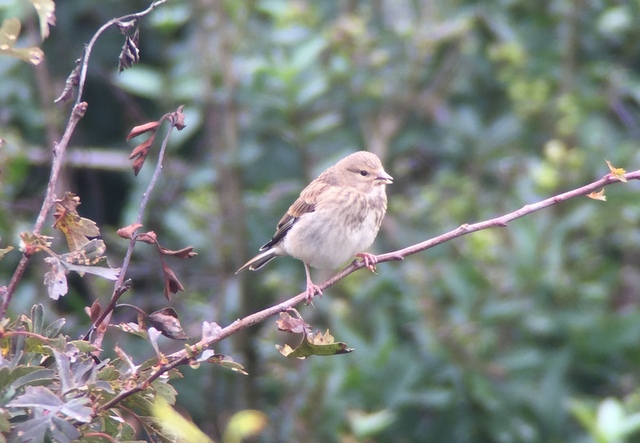 Linnet – several were in the boardwalk bushes as usual
Linnet – several were in the boardwalk bushes as usual
The bushes by the boardwalk seemed a little quiet at first, but as we stood quietly and looked closely, more birds appeared. There were several Linnets as usual, a couple of the juveniles still begging food from the attendant adults, and the regular Dunnocks. A Chiffchaff appeared low down in brambles next to one of the local Common Whitethroats. A Goldcrest flew across between the bushes and disappeared into the undergrowth calling.
Then the biggest surprise of all – a Tree Sparrow dropped in. We watched it for a while, but it was very restless, moving around between the brambles and the apple tree. Tree Sparrows are getting very scarce in Norfolk now and are very unusual out here, so this was a real treat. Then suddenly it took off and flew strongly west towards Gun Hill.
While we were standing by the boardwalk, we heard the first group of Siskins flying over. They have been on the move for over a week now and there was a steady stream passing overhead this morning, calling as they flew west over the dunes. Once or twice in amongst them we could hear a Redpoll or two calling as well. While we were in the dunes, we tried to keep a count – at least 265 went through. More Siskin flew over while we were in the pines, but we couldn’t see them to count them, so the actual total past this morning would have been a bit higher. Real visible migration in action.
 Common Buzzard – watching from up in the dunes
Common Buzzard – watching from up in the dunes
From the boardwalk, we made our way east towards the pines. A Common Buzzard sat up in the tops of the dunes. A Wheatear appeared on the fence just in front of us, but unfortunately we were already too close and it darted off again immediately. Thankfully, as we walked over the crest of the dunes, we could see it or another Wheatear down on the path just ahead of us. It flicked up and landed on the fence where we could get a good look at it through the scope.
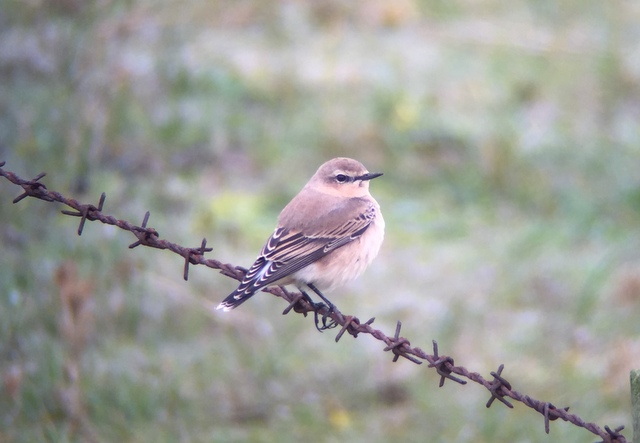 Wheatear – perched on the fence on the edge of the dunes
Wheatear – perched on the fence on the edge of the dunes
There have been several Redstarts in the dunes in recent days and, although we had seen one briefly on the walk out, we wanted to get a better look. As we walked towards the west end of the pines, we could hear Redstarts calling. From a convenient high vantage point in the dunes, we scanned the bushes. First we picked up a young male Redstart, with white feather tips partially obscuring its black face, then a female flicked up into a hawthorn nearby. The male showed particularly well, perching in the brambles and branches of a dead young elder just beyond the fence.
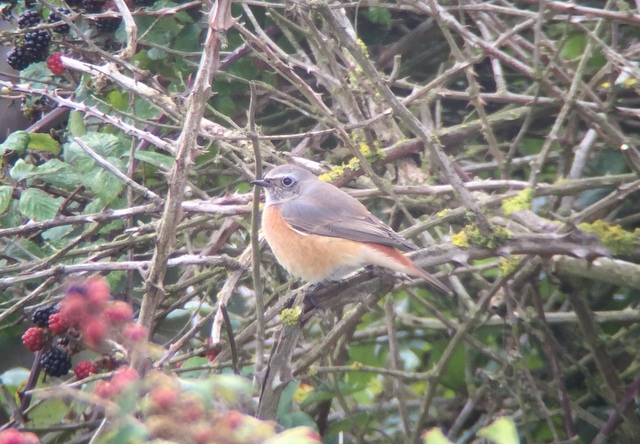 Redstart – this male showed particularly well
Redstart – this male showed particularly well
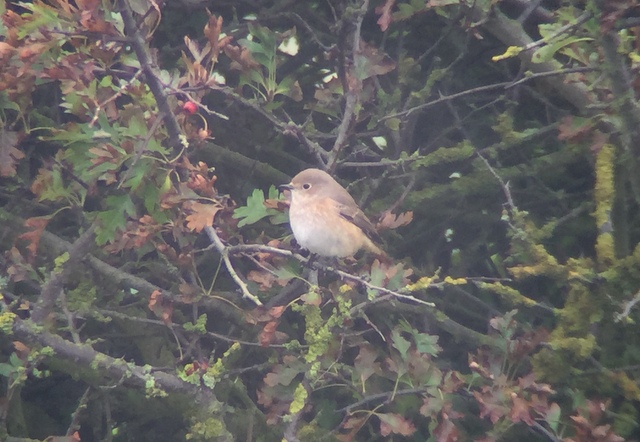 Redstart – the plainer female was a little more shy
Redstart – the plainer female was a little more shy
While we were admiring the Redstarts, a glance across the grazing marshes towards the wood revealed a large white shape flying across. There has been a Great White Egret hanging around at Holkham for getting on for three weeks now, but at times it has been rather elusive. We could immediately see how big it was as it dropped down onto one of the pools. We hadn’t intended to walk any further, but with the promise of getting a better view of the Great White Egret we set off to walk to Joe Jordan hide.
The walk along the path on the south side of the pines was uneventful at first. As we got almost to the crosstracks, we could see the Great White Egret out on the pool preening, so we had a quick look at it through the scope in case it flew off again. That also gave us the opportunity to stop and scan through the tit flock which was feeding in the pines before the hide. There was the usual variety, Long-tailed, Coal, Great and Blue Tits, Goldcrests, Treecreeper and Chiffchaffs.
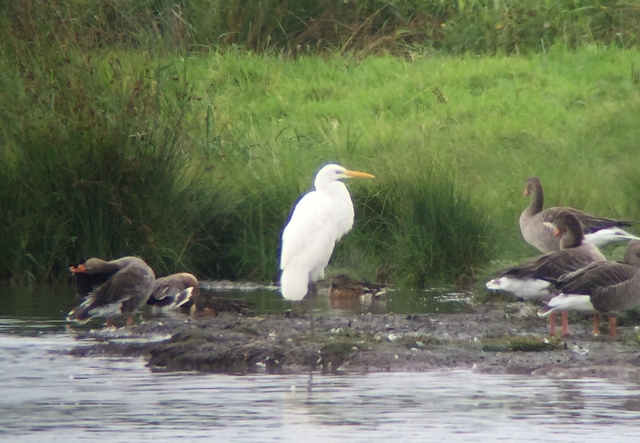 Great White Egret – towering over the local Greylag Geese
Great White Egret – towering over the local Greylag Geese
From up in the hide, we got a much better view of the Great White Egret. There was a Little Egret on the other side of the pool which allowed a great size comparison – the Great White Egret looked huge even next to several big Greylag Geese! While we were in the hide, a Red Kite drifted in and circled the trees, landing in the tops for a while. There were also several Marsh Harriers flying back and forth.
After a suitable rest in the hide, it was time to head back. As we walked along the path just a little west of the hide, yet another Redstart flew across in front of us, again flashing a red tail as it went, our fourth of the day. The rest of the way back to the boardwalk was fairly uneventful, although the Wheatears had multiplied – there were now two on the fence. We had enjoyed much better weather during the morning than we had anticipated, but we could now see dark clouds to the south of us. At first they seemed to be passing us by, but as we turned to head south along the seawall we finally ran into a little rain. Coats on, we walked back quickly and thankfully the worst of it missed us.
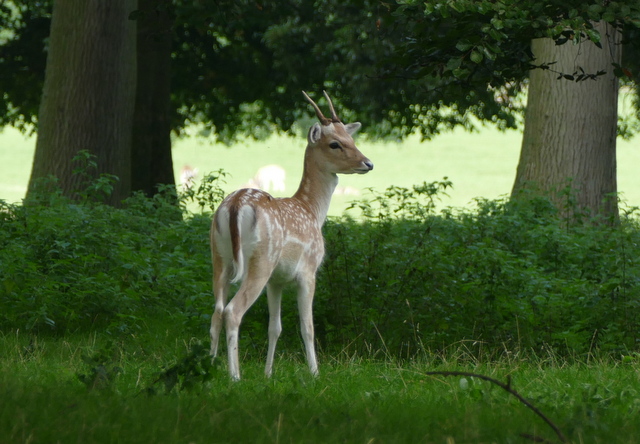 Fallow Deer – there is a large herd in the deerpark at Holkham Hall
Fallow Deer – there is a large herd in the deerpark at Holkham Hall
We drove round to Holkham Hall for lunch, and sat out the rain while we ate. Some of the resident Fallow Deer herd came to look at us. A Nuthatch was calling in the trees nearby and another Red Kite drifted over the park. It stopped rainging and brightened up nicely just as we finished, with even patches of blue sky overhead, so we walked down to the lake. An injured Pink-footed Goose was hanging around with the flock of Egyptian Geese across on the other bank.
There had been a juvenile Black Tern around the lake for the past couple of days, but it gave us the run around for a while. There was no sign of it around the southern end, so we set off to walk to the other side. We were about half way along when the Black Tern appeared ahead and flew along the edge of the lake right in front of us – straight back to where we had just been standing! As we turned to walk back, we watched it hawking over the water, dipping down occasionally to the surface. Needless to say, when we got back to where it was, it immediately set off back towards the northern end. We had had a good look at it so decided to leave it to it.
We headed round to Wells Woods to finish the day. There had been a report of two Pied Flycatchers there earlier, but we struggled to find any birds at all at first. It was very disturbed with lots of dogs running amok and their owners standing nearby shouting and whistling. We made our way over to the relative quiet of the drinking pool and quickly located one of the local tit flocks. As well as the regular variety of tits, Goldcrests and Treecreepers, we could see one or two Chiffchaffs and a single Willow Warbler, but no Pied Flycatcher. A Green Woodpecker called nearby and a Great Spotted Woodpecker did the same.
Out in the brambles on the edge of the trees, we found a Lesser Whitethroat. It made itself elusive at first but we followed it as it flitted between the bushes calling. Eventually it landed in a small hawthorn and sat out in the now emerging afternoon sunshine. Then a second Lesser Whitethroat appeared with it. A browner Common Whitethroat, with rusty wings, hopped out nearby. Another tit flock whisked through.
 Small Tortoiseshell – one of several butterflies out in the afternoon sun
Small Tortoiseshell – one of several butterflies out in the afternoon sun
There were still a few insects about. With the sun coming out, the butterflies came out too. We had seen one or two Speckled Wood earlier, but now we found several Red Admirals and a Small Tortoiseshell basking in the sun. One of the sharp-eyed members of the group spotted a large caterpillar on the path as we walked through the pines – on closer inspection, a Pine Hawkmoth caterpillar. There were also a few dragonflies buzzing around – Common Darters and Migrant Hawkers.
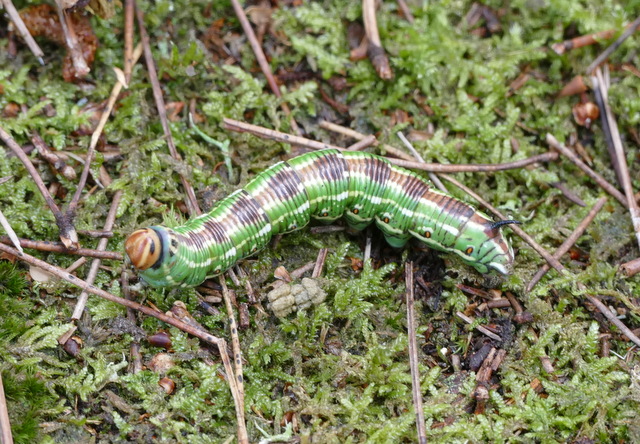 Pine Hawkmoth caterpillar – on the path in the pines
Pine Hawkmoth caterpillar – on the path in the pines
We made our way back via the Dell, but still with no sign of the flycatchers. Almost back to the car park, just before the boating lake, we came across yet another small tit flock on the edge of the pines by the main path. We stood watching it for a while, with a couple of Long-tailed Tits performing for the crowd. We were just about to leave when something flitted across high up in the pines – a Pied Flycatcher! Unfortunately it didn’t hang around and, no sooner had it appeared than it was off through the tops of the pines and we couldn’t find it again. Still, it was a nice way to round off the day.
